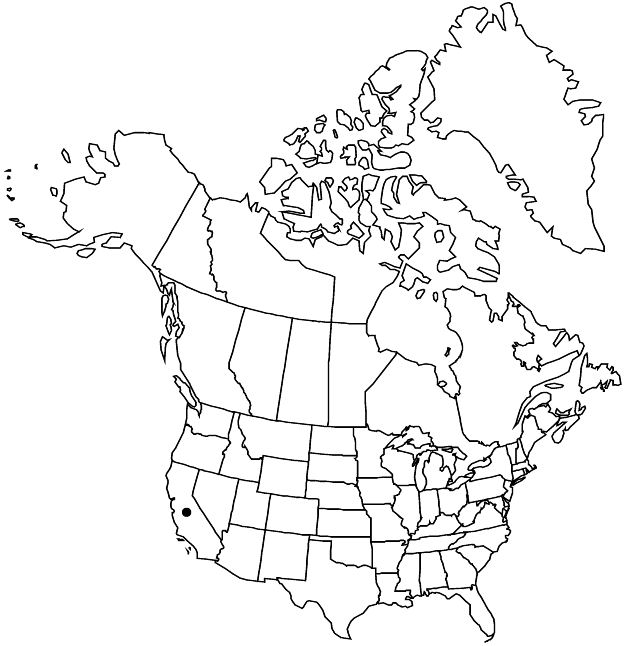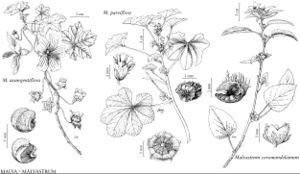Difference between revisions of "Malva assurgentiflora"
Novon 8: 290. 1998.
FNA>Volume Importer |
imported>Volume Importer |
||
| (3 intermediate revisions by 2 users not shown) | |||
| Line 13: | Line 13: | ||
}}{{Treatment/ID/Special_status | }}{{Treatment/ID/Special_status | ||
|code=F | |code=F | ||
| − | |label= | + | |label=Illustrated |
}}{{Treatment/ID/Special_status | }}{{Treatment/ID/Special_status | ||
|code=W | |code=W | ||
| Line 21: | Line 21: | ||
|name=Lavatera assurgentiflora | |name=Lavatera assurgentiflora | ||
|authority=Kellogg | |authority=Kellogg | ||
| + | |rank=species | ||
|publication_title=Proc. Calif. Acad. Sci. | |publication_title=Proc. Calif. Acad. Sci. | ||
|publication_place=1: 14. 1854 | |publication_place=1: 14. 1854 | ||
| Line 27: | Line 28: | ||
|name=L. assurgentiflora subsp. glabra | |name=L. assurgentiflora subsp. glabra | ||
|authority=Philbrick | |authority=Philbrick | ||
| + | |rank=subspecies | ||
}} {{Treatment/ID/Synonym | }} {{Treatment/ID/Synonym | ||
|name=Saviniona assurgentiflora | |name=Saviniona assurgentiflora | ||
|authority=Greene | |authority=Greene | ||
| + | |rank=species | ||
}} {{Treatment/ID/Synonym | }} {{Treatment/ID/Synonym | ||
|name=S. clementina | |name=S. clementina | ||
|authority=Greene | |authority=Greene | ||
| + | |rank=species | ||
}} {{Treatment/ID/Synonym | }} {{Treatment/ID/Synonym | ||
|name=S. reticulata | |name=S. reticulata | ||
| − | |authority= | + | |authority= |
| + | |rank=species | ||
}} | }} | ||
|hierarchy=Malvaceae;Malvaceae subfam. Malvoideae;Malva;Malva assurgentiflora | |hierarchy=Malvaceae;Malvaceae subfam. Malvoideae;Malva;Malva assurgentiflora | ||
| Line 60: | Line 65: | ||
-->{{#Taxon: | -->{{#Taxon: | ||
name=Malva assurgentiflora | name=Malva assurgentiflora | ||
| − | |||
|authority=(Kellogg) M. F. Ray | |authority=(Kellogg) M. F. Ray | ||
|rank=species | |rank=species | ||
| Line 74: | Line 78: | ||
|publication title=Novon | |publication title=Novon | ||
|publication year=1998 | |publication year=1998 | ||
| − | |special status=Endemic; | + | |special status=Endemic;Illustrated;Weedy |
| − | |source xml=https:// | + | |source xml=https://bitbucket.org/aafc-mbb/fna-data-curation/src/2e0870ddd59836b60bcf96646a41e87ea5a5943a/coarse_grained_fna_xml/V6/V6_525.xml |
|subfamily=Malvaceae subfam. Malvoideae | |subfamily=Malvaceae subfam. Malvoideae | ||
|genus=Malva | |genus=Malva | ||
Latest revision as of 22:21, 5 November 2020
Shrubs, 1–4 m, stellate-hairy to glabrate. Stems erect to decumbent, base woody. Leaves: stipules early-deciduous, lanceolate to ovate, 2–4 × 0.6–1.5 mm, minutely stellate-puberulent; petiole as long as or longer than blade; blade free filaments 1–2 mm; anthers on distal 1/2; style 6–10-branched (same number as locules), purplish; stigmas 6–10 (same number as locules), purplish. Schizocarps 12–16 mm diam.; mericarps 6–10, 6–7 mm, apical face and margins sharp-edged, surfaces smooth to faintly ribbed, glabrous or puberulent on apical surface. Seeds dark brown, 4 mm, nearly as thick as long, notch slight. 2n = ca. 40.
Phenology: Flowering Feb–Jun and Sep–Oct, sporadically year-round.
Habitat: Coastal bluffs, disturbed areas
Elevation: 0–400 m
Distribution

Calif., introduced in Mexico, Central America (Guatemala), South America (Bolivia, Chile, Ecuador, Peru), Pacific Islands (New Zealand), Australia.
Discussion
Malva assurgentiflora, traditionally placed in Lavatera, has long been cultivated as an ornamental or windbreak in California and is native only on the Channel Islands. It has become naturalized on the mainland as well as in Mexico and sparingly elsewhere. The shrubby habit, large flowers with dark-veined petals, and thick, hemispheric, fruits make it distinctive; it is our only native species of Malva. The petals are often recurved with age, and the corky mericarps float and are tolerant of salt water. Further study may indicate that there are two distinct subspecies, as suggested by R. N. Philbrick (1980).
Selected References
None.
